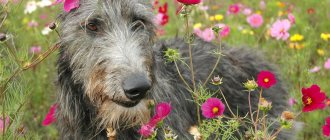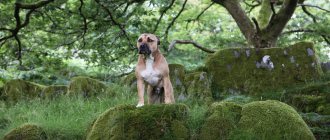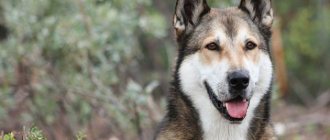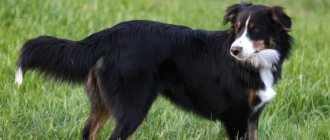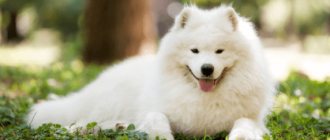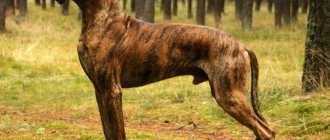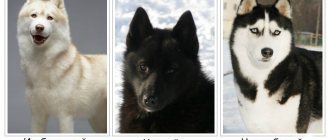Description and features
A large animal with a powerful build and well-developed muscles. It is of impressive size, but looks fit and light thanks to its long legs. The Anatolian Shepherd breed has the following parameters according to the FCI standard:
Height at withers for males is 74-81 cm, weight 50-65 kg, for females: height 71-79 cm, weight 40-55 kg. Here I would like to note that with such height and muscles, this weight is not burdensome for these shepherd dogs. They are fast in their movements, run fast and jump well.
The head is large, the skull is voluminous. Powerfully developed jaws, the upper teeth tightly overlap the lower ones and are located perpendicular to the jaw. This is called a correct scissor bite. The lips are black at the edges, slightly drooping, and there are no pockets at the corners of the mouth. Males have larger heads than females.
Any color is acceptable - plain (white, black, light gray, fawn), combined (for example, brindle) and even tricolor (black-gray-red). But the most common is white and cream. A distinctive feature is considered to be a black “mask” on the face - in Turkish “karabash” (black head), hence one of the names of the dog.
The ears should be the same black or darkened color. They are often cropped so that they are not torn off by predators during a fight, and it is also believed that dogs with cropped ears hear better. Uncropped ears hang in triangles on the sides of the head, appearing soft and slightly sheep-like.
The coat is short or medium length, but always with a thick undercoat, which saves the dog from the cold, and the top layer of coat also has a water-repellent effect from rain and snow. This is universal protective clothing - against harsh climates, as well as against thorny bushes, mosquitoes and predators.
The tail is straight and slightly curved. It is not customary to buy it. When the dog is alert, the tail curls into a ring, rising high behind the back, especially in boys. The Anatolian Shepherd in the photo looks both reliable and dangerous.
A powerful animal that can strangle a large wolf almost without effort. And at the same time, the dog realizes his strength, calmness and generosity are observed in his gaze: “I am strong, but I will not offend you.”
The Anatolian Shepherd is one of the largest and strongest dogs
Exterior according to FCI standard
Before talking about the global standard, it is imperative to mention the fact that almost every country in the world has its own standard for this breed of dog. The difference between them is generally not significant, but its essence lies in the size of the representatives of the breed. The native Turkish standard provides for a height limit at the withers of 65-78 centimeters without dividing by height for females and males.
The UK standard provides for two height options: females 71-79 centimeters, males 74-81 centimeters, and weight is not divided by gender. The New Zealand standard divides both by height and weight: females 71-78.5 centimeters in 41-59 kilograms, males 74-81.5 centimeters in 50-63 kilograms. The US standard, like the New Zealand standard, divides it as follows: males 76-81 centimeters in 50-66 kilograms, females 71-76 centimeters in 41-54 kilograms.
In general, it is clear that the dog is far from miniature, but there is still a difference. The FCI standard still insists on females 71-79 centimeters and 40-55 kilograms, males 74-81 centimeters and 50-65 kilograms.
The massive head must contain a very important feature - the length of the convex and wide skull must be greater than the length of the muzzle. Also, the male’s head should always be larger than the female’s so that the sexes could be visually distinguished. The transition from the forehead to the muzzle is weakly expressed, but a flat skull is also considered a violation of the standard. The rectangular muzzle is blunt and tapers slightly towards a black lobe.
IMPORTANT: the lobe should always be black, with the exception of the liver color of the coat, then a brown color of the lobe is allowed.
The lips are slightly drooping and black along the edges. The upper lip should not hang below the edge of the lower jaw; jowls and pockets in the corners of the mouth are not allowed. Strong jaws have a full dentition with a scissor bite. The eyes are set wide apart, the iris is in harmony with the color of the coat. The medium-sized triangular ears are rounded at the tips and fall to the cheekbones. Docking is allowed if the dog is a working dog.
The thick and muscular neck is slightly curved, has a dewlap, and goes into an equally powerful body with a straight back line. Convexity is allowed in the lumbar region. The back is shorter than the length of the legs, while short legs are considered a disqualifying fault. The chest is long, deep, and the ribs are curved. The stomach is pulled towards the groin.
The tail is set high, slightly curled, and in an excited state it curls over the back in a ring. Cannot be purchased. Long paws with large bones, widely set. The paw pads are elastic and thick-skinned, and the nails are short. It is desirable to have profitable fingers; they are often double.
The Turkish breed is light in its movements, moving to an amble at low speeds, and in general the style of movement is creeping, with the head, neck and back at the same level.
The coat is short, sometimes semi-long if the ancestors of a particular individual are from colder areas. The undercoat is thick, thickens before winter, and the hairs of the top layer become longer.
In terms of color, there are no restrictions - the color can be any, but most often it is beige and milky. A dark mask on the face is required, usually black.
Kinds
The concept of "Anatolian Shepherd" was not accepted by the Turks because they also have other shepherds that fall under this definition.
- The closest relative of our Anatolian is the Kangal Karabash; the breed standard was developed in 2001 in Turkey near Sivas, which is why it is called Sivas Kangal. But the breed is not accepted as an independent breed in the world.
For a long time, many people mistakenly called the Anatolian karabash kangal. But recently, in order to avoid confusion, a single name was adopted for animals of this breed. In practice, they are now considered inbreeding species. Unlike the Anatolian carabash, the galangal has only one color - gray-fawn with a black mask.
- Akbash – “white head”. A dog of the same ancient pedigree as the Kangal. Some believe that they may even be the ancestors of the Kangal Shepherd. Its white color and soft coat allows it to be invisible among the herd.
A large dog enters into battle not only with wolves, but can resist a puma and even a bear. Hardy, powerful, very fast, it was deservedly appreciated in the 70s of the last century by farmers in America, where it is used to this day.
Her signature running leap allows her to catch up with any fleeing predator. The dog cannot be kept on a chain; its character immediately deteriorates. Freedom, open spaces, grazing herds - these are his elements.
- Kars is also an ancient dog originally from Turkey. The color of the shaggy coat is black. White spots and inclusions are acceptable on the chest, legs, tail and neck. A large, beautiful, strong dog with powerful paws. It is very common in its homeland among shepherds, but is gradually becoming popular in America and Europe.
- Aksaray Malakli (Malkali) is a Turkish Mastiff or Central Anatolian Shepherd Dog, another large breed of guard dog originally from Aksaray. Outwardly, it is very similar to a Kangal dog, only it has stronger and thicker legs, and large drooping lips (“malakli” means “with lips”). Of all the Turkish Shepherds, it is perhaps the largest.
There was an opinion to unite all these famous breeds, including the Karabash, under one name - the Anatolian Shepherd, but Turkish breeders, fortunately, opposed the merger of the breeds. Thanks to this, we still see similar, but very different dogs, each wonderful in its own way.
History of the breed
The ancestors of the Turkish wolfhound remember the city of Babylon. And this - it’s scary to imagine - from 3000 BC. e. Even then, the dog was used in hunting lions and wild onagers (an equine animal). The British Museum has Assyrian bas-reliefs that depict hunting episodes involving these dogs. But Assyria is a very ancient state of Mesopotamia. It ended its 2000-year existence in the 7th century BC, when it came under the destructive influence of Media and Babylonia.
From time immemorial, the Turkish Shepherd was not a shepherd dog, but a watchdog and security dog. She protected herds of sheep from wolves and other predators. For many centuries, the Turks worked on this breed, crossing various types of large dogs. They wanted to produce a universal shepherd dog - a shepherd, watchman and hunter.
As a result, a large, agile, very fast and intelligent dog was formed, which for many years was called the “Anatolian Shepherd”. Turkish breeders jealously guarded the integrity of this breed; it is not allowed to be exported abroad in order to avoid crossing with other dogs. But by unknown means, in 1967, the first litter of Turkish Shepherds was produced in Britain.
In the United States, the first breeding programs for these animals began in the early 1980s. The breed is recognized by the United Kennel Club in the USA, as well as by the national kennel clubs of South Africa and New Zealand. This is how the “non-travelable” dog spread throughout the world. Now carabash are bred in Germany.
Despite its size, the Anatolian Shepherd is fast and resilient.
In 2013, the British Kennel Club announced that it recognizes the "Kangal Shepherd" breed, and all dogs registered as Anatolian Shepherds can be registered as Turkish Kangal dogs. A little earlier, the Australian National Nursery Council made the same decision.
And on June 15, 2021, the International Canine Organization introduced a population model for a single breed - the Kangal, and approved changing the name of the breed " Anatolian Shepherd Dog " to "Kangal Shepherd Dog". So now we can legally call this dog that.
History of the Turkish breed
The Kangal is the only Turkish dog breed that has been recognized throughout the world. It is revered as a national treasure and represented as a symbol in the former Ottoman Empire. The export of these dogs is controlled by the state.
Kangal gained worldwide fame in the 80s of the last century, when it was first exported to the USA, and from there it spread to Western European countries.
In Turkey the breed is highly prized as a herding guard dog , they are said to be descended from northern dogs, as evidenced by their curved tail and short coat.
In terms of working qualities, this dog has no equal; the Kangal was often used to protect the herd from wolves and other predatory animals. In Russia and European countries, the dog plays the role of a guard.
Character
The popularity of the Anatolian, which is gaining momentum year after year, is largely due not only to its working qualities, but also to the character of a wonderful dog. And also with behavioral characteristics. According to the standard, the character of the Anatolian Shepherd should be self-controlled, vigilant, calm, sensitive, independent, and protective.
Of the six definitions, two are with the prefix “self”. This indicates that the dog is capable of analytical thinking, ingenuity, has high intelligence and a subtle mind. In a family, she singles out one owner, but is affectionate and friendly with everyone, especially with children. She is strict with strangers and does not allow them to take the owner’s belongings or enter the territory without permission.
If you train her correctly, she will be not only a guard, but also a friend, a pet, a nanny, and a family therapist. The voice is loud, booming, booming, but she will not bark for no reason. An important factor in determining its character is that these dogs are accepted into the state police service in Turkey.
The Anatolian Shepherd dog is extremely hardy and can work outdoors in any weather. Her character has independence and love of freedom, which is why it is necessary to start training her on time. If this is your first pet and you have no such experience, be sure to contact a professional. You can’t just subjugate it to yourself; you need the right and competent approach. Soft and weak-willed people should not have such a dog.
Nutrition
The easiest way is to choose ready-made extra-class or holistic food, which provides the necessary microelements and a balanced menu. If you decide to feed natural food, follow some rules. There is no need to give fatty, floury, spicy, salty and sweet foods. The dog should not experience problems with the stomach, teeth and heart.
The best options are boiled lean meat and boneless fish, as well as cereal porridge in broth with the addition of vegetable oil. Include more dairy products, it is good for bones. Give vitamins and fiber in the form of vegetables. Potatoes and pasta are allowed no more than once a week. Sometimes you can have a raw egg or fruit.
Don't forget to pamper your pet with a large bone. Regarding nutrition, consult your veterinarian, he will help you create a balanced diet. An important rule that should never be broken is that the water bowl must always be clean and filled.
Reproduction and lifespan
Dogs are ready to breed at about two years of age. It is advisable to carry out mating on the territory of the male, where he will feel more confident. Both applicants must be pure breed, healthy and vaccinated. A dog does not have any difficulties during pregnancy; nature has perfected this process over the centuries.
There are 4-5 babies in a litter. Anatolian Shepherd puppies have a black “mask” on their face since childhood, like all babies, they are curious and playful. In fairness, it must be said that there are practically no problems from babies, they are confidently controlled by their mother. She also teaches them the first basics of social adaptation. With fairly good care, they live 13-15 years.
Health and life expectancy
Kangals are very strong and hardy dogs; people began to participate in their breeding quite recently; before that, nature itself selected the strongest. However, the breed is susceptible to problems that are common in large dogs: hip dysplasia and gastric volvulus. Having a predisposition to these diseases, the dog may never get sick, because to a greater extent they are provoked by improper nutrition and maintenance.
Care and maintenance
You cannot keep such a pet in an apartment. It is absolutely not urban. The dog does not know how to be lazy, lying on the sofa or on the rug, it is difficult for him to live without work. In the apartment he will feel like in a cage. But it is undesirable to put him on a chain, he can literally go brutal. It is best to keep him in a private house behind a fence, where he can move freely.
Does not require special care, requiring only standard attention for dogs with medium coat. Brushing twice a week. Dogs don't smell or get particularly dirty, so there's no reason to bathe them often. Of course, the teeth, ears and eyes require attention. All this must be periodically cleaned and washed.
The dog should have its own place to rest and at least two bowls - for food and for water. It is important that from childhood he understands that he should not sleep on the master’s sofa. Dogs love to swim in a river or other body of water; in the summer, let him swim in the water. In winter, you can rub your pet with snow. The dog needs daily walks for at least an hour.
Breed diseases:
- Hypothyroidism (thyroid disease);
- inversion of eyelids;
- Spinal injuries;
- Skin diseases.
A problem that is not alien to galangals is decreased immunity. And one more very important information. If your dog unexpectedly requires surgery under general anesthesia, please do a medication test first. Many Kangals cannot tolerate anesthesia.
Maintenance and care
The Kangal is not designed to be an ordinary pet. He will not lie for hours at his owner’s feet in complete inactivity. He is not comfortable indoors; due to its large dimensions, even a large apartment will seem cramped to such a dog.
The Kangal Shepherd was created to serve man. This is a working breed; without physical activity and tasks, the Kangal's character can deteriorate; from boredom, he can become aggressive and uncontrollable.
The Turkish karabash vitally needs large space, fresh air, and the ability to move freely.
It is not recommended to put him on a chain, as there is a possibility that the dog will become embittered and his level of unjustified aggression will increase.
City life is not for Kangals. The ideal option is a country house with a large, fenced area. The fence should be high enough, since the height of representatives of the breed can reach 1 meter at the withers.
If the dog stands on its hind legs, an ordinary fence will not present any obstacle for it.
By nature, karabash is extremely hardy. He is able to live in the open air, performing guard duty day and night. But an indoor enclosure with a large booth or a special house where the dog can hide from natural precipitation must be installed in the yard.
The kangal should not sit in the enclosure all the time. If he is not busy with security or shepherd work, arrange active walks for him 2-3 times a day.
To maintain the health and beautiful appearance of the Kangal Shepherd, its owner must properly care for it. The following procedures will be required:
- Brushing the coat once a week. During the molting period, combing is carried out more often, 2-3 times a week. Particular attention is paid to this procedure in the spring, at which time the kangal sheds very heavily.
- Bathing once every 3-4 months. We give the carabash an unscheduled bath if it is heavily soiled. On other days, sometimes we run a damp towel over the fur, removing dust.
- Trimming the claws as they grow back, this procedure is rarely carried out, since the Kangal wears them off on its own.
- Weekly ear examination. This requires cleaning using special products.
The basis of a balanced, natural diet is low-fat meat products, offal, and cereals. Potatoes and peas are excluded. Vitamin and mineral supplements and additions to the diet in the form of vegetables and fruits are important.
Feeding with dry food is allowed. This method is simpler, it is completely balanced, it contains all the necessary additives, but only if the food is premium.
It is not recommended to alternate natural and artificial nutrition. This may negatively affect the health of the Turkish Karabash.
It is important to correctly determine nutritional standards and diet. The owner should be aware that his Kangal Shepherd is prone to obesity.
If left unchecked, she will regularly overeat and eventually gain weight quickly. This will lead to problems with the gastrointestinal tract and cardiovascular system.
Price
Anatolian karabash is not a cheap pleasure and is quite rare. We strongly advise against purchasing a puppy at a poultry market, although even there a dog will cost about 30,000 rubles. For private breeders, the price is set from 40,000 to 50,000 rubles. Babies with minor defects (non-standard color, white spots on the body, too long hair) are much cheaper.
There are also breeding nurseries on the territory of the Russian Federation - monobreed or complex breeding. The price of a pure breed Anatolian Shepherd in a kennel is approximately 65,000-70,000 rubles, and an “elite class” puppy will cost 120,000-130,000 rubles. Another piece of advice – when choosing a puppy, rely on the opinion of a respected specialist.
How to choose a puppy
It is very difficult to purchase a kangal, given the ban by the Turkish authorities on the export of purebred individuals. But this only increases interest in dogs of this breed. From private breeders, a puppy can cost at least 30 thousand rubles, but no one will guarantee the purebred of the baby. Of course, you can distinguish them by their specific color, but even a specialist will not be able to evaluate the rest of the characteristics of a dog at a young age.
Even Kangal puppies are not afraid of harsh weather conditions
There are also nurseries, rarely single-breed (for example, Antalkaya), more often breeding similar breeds, for example, Alabais. Here a puppy can cost from 65 thousand rubles, and the most promising babies can cost 120 thousand rubles.
Interesting Facts
- The breed is currently recognized as a national treasure of Turkey, it can be seen on advertising brochures, badges, among souvenirs and on coins. In some Turkish families, there is a custom to give the family a Karabash puppy for the birth of their first child.
- Shepherds often tell stories that Kangal Shepherds, when they find a sheep, selflessly protect it for several days, going without food or drink.
- In Namibia and Kenya, Kangal Shepherds are used to protect livestock from cheetahs. And the cheetah, for your information, is the fastest predator on the planet. Where these dogs have been employed, livestock losses have been significantly reduced.
- The protective coloring of the karabash had another amazing feature. Thanks to such wool, the dog did not frighten the sheep with its appearance, to the point that they allowed it to nurse their lambs.
- Ear cropping of a Kangal Shepherd is considered illegal in some countries, such as the UK.
- Anatolian Shepherds often choose a place on a hill to survey the surroundings, and they generally try to lead the family pack. The Kangal may not accept a second large dog, but a small dog or any other animal will be protected and loved.

